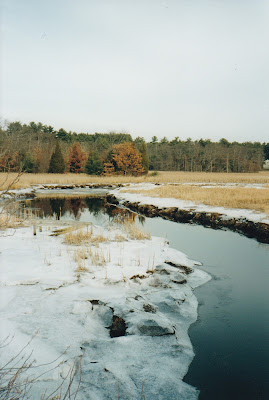 |
| The South River Marsh in winter. |
The salt marsh in winter doesn’t look like much. From a distance it appears to be mostly dead, matted brown grass standing in clumps along the surfaces of large frozen chunks of mud — a sharp contrast to the vivid greens of late spring and early summer. As dead as it may appear however, the salt marsh in winter has many living components. While marsh population decreases dramatically as the weather grows colder, life is present there, only in smaller, quieter ways.
In some ways, the marsh seems more hospitable in winter. The estuary water which flows in and out of the marsh with the rising and falling tides is clearer than it is all year, permitting sunlight to penetrate to greater depths. The decay of vegetation that flourished in the summer leaves the water full of nutrients, permitting rapid growth of plankton. But that’s where the hospitality ends.
If the winter is severe enough to freeze the water of the estuary, even just on the surface, the marsh becomes a forbidding place for the vegetation that thrives there. Marsh grass has little chance of surviving the cold temperatures as it is, but when high tides and storms push this ice onto the frozen mud, it moves across the grass, crushing and grinding it, cutting off anything protruding above the surface. All that remains alive by winter’s end are the roots, protected by a insulating coat of wet or frozen mud.
The winter salt marsh is not a hospitable place for animals either. While the water that floods and retreats from the marsh twice each day stays relatively warm (as compared to the air), the mud can get pretty cold. Even when there is ice on the water, the mud is colder, especially that which rises above the high water line.
Most of the birds, fish and other wildlife that inhabit the marsh during the other seasons migrate to warmer climates for the winter. Others stay, but become extremely inactive. For example, insects and crabs burrow into the mud and grow so cold that, while still alive, they do not respond to any sort of stimuli. An occasional fish may attempt to feed at the edge of the marsh, searching for an errant bug or crab, but in general the fish that stick around for the winter seek food elsewhere.
Birds require a continuous supply of food to keep their bodies warm, so many of those that inhabit the marsh in the warmer months go south for the winter. Still, there are a number of birds that make the winter marsh their home, such as Virginia rails, herons, curlews, sandpipers, plovers, ducks and geese. As the marsh is frozen and pretty much devoid of life, these birds must find food in the creeks, chasing fish and poking through the mud in search of the worms that burrow there. As there are not many fish at this time of the year and the marsh mud is often frozen, this makes meals a rather difficult venture.
Despite its lifeless appearance, the salt marsh can be an interesting place to explore in the winter. In fact, winter is probably the best time to explore the marsh by foot, as at other times of year the tall grasses make it easy to get lost. Take advantage of the dead, matted grass to set out for a walk across the salt marsh. Follow a tidal creek and see where it empties into the river. Many of the local open space areas, such as Norwell’s Norris Reservation, Scituate’s Driftway Conservation Area, and Marshfield’s Corn Hill Woodland and Nelson Forest, offer excellent salt marsh access.
by Kezia Bacon, Assistant Director, North & South Rivers Watershed Association
January 1997
